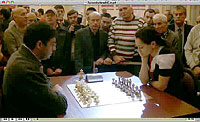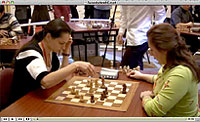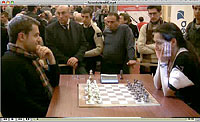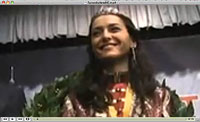10 greatest chess games of all time by GM Mickey Adams
Chess news and chess trivia blog (c) Alexandra Kosteniuk, 2010
Guess what British Grandmaster Mickey Adams did after finishing the London Chess Classic 2010. He wrote this fantastic article for Daily Mail about the 10 greatest chess games of all time. Real cool selection. Here is the list from the talented grandmaster's article at the Mail Online link. Nice chess treat. Enjoy.
1. DEEP BLUE vs GARRY KASPAROV
New York, 1997. 19 moves. Win: Deep Blue
Garry Kasparov, undisputed world champion from 1985 to 1993, became the first champion to lose a match to a computer
In this landmark clash Kasparov became the first champion to lose a match to a computer. At the time, Kasparov, undisputed world champion from 1985 to 1993, was still very much at the top of his game. Deep Blue, a huge mainframe computer, was an experimental IBM project. In the first five games man and machine had won a game apiece and drawn three times, thus making the sixth, final game decisive. Kasparov (black) employed the Caro-Kann defence, not one he normally used: he didn't believe the computer could make the necessary early sacrifice. The strategy was flawed. Deep Blue made the sacrifice and followed up effectively. The game witnessed a real collapse by Kasparov - there is intense pressure when playing against an unyielding machine. At the time computers weren't as strong as the strongest players, but now there's little interest in man-machine matches - you have to make conditions so favourable to humans that they're no longer interesting events.
2. ANATOLY KARPOV vs GARRY KASPAROV
Moscow, 1985. 42 moves. Win: Kasparov

Featuring two of the greatest players of all time - Anatoly Karpov (far left) and Garry Kasparov - this game proved a thrilling conclusion to a match that Karpov needed to win in order to retain his world titke
Featuring two of the greatest players of all time - Karpov (far left) was world champion from 1975 until 1985 - this game provided a thrilling conclusion to a match that Karpov needed to win in order to retain his world title. Kasparov (black) employed his favourite Sicilian Najdorf defence, with which he scored brilliantly throughout his career. In later matches Karpov no longer challenged him in this opening. The game turned on an unusual choice of Kasparov's on his 23rd move, putting his rook on a square that on the face of it seemed to offer few prospects. Later on, he managed to open that sector of the board and activate his pieces there, and it became apparent how far-sighted the rook move had been.
3. BORIS SPASSKY vs DAVID BRONSTEIN
Leningrad, 1960. 23 moves. Win: Spassky
This clash took place when Russia dominated the worldwide game. Spassky - a Soviet grandmaster and future world chess champion (1969-72) - and Bronstein were pretty evenly matched. Bronstein, also a Soviet grandmaster, narrowly missed out on becoming world chess champion in 1951 and was strong and creative. The game began with Spassky (white) using the King's Gambit opening. All his pieces flowed into the action very quickly. He concluded with a nice attack, sacrificing a knight to open up the pawn cover in front of his opponent's king. Then his pieces flowed in on the light squares. This game was the model for the chess scene in From Russia With Love.
4. MAGNUS CARLSEN vs THE WORLD
New York, 2010. 44 moves. Win: Carlsen
Norwegian Carlsen was the top-rated player and at 19 the youngest ever World No 1. 'The World' was advised by three top players: Hikaru Nakamura (U.S.), Maxime Vachier-Lagrave (France) and Judit Polgar (Hungary). Their suggestions were put to a live vote on the internet. On paper, The World had a reasonable chance, but with three players advising it's difficult to form a coherent plan. In a King's Indian defence Carlsen could have won in a mundane way, but instead he finished in striking fashion, his passed pawns on the queenside proving unstoppable.
Featuring two of the greatest players of all time - Karpov (far left) was world champion from 1975 until 1985 - this game provided a thrilling conclusion to a match that Karpov needed to win in order to retain his world title. Kasparov (black) employed his favourite Sicilian Najdorf defence, with which he scored brilliantly throughout his career. In later matches Karpov no longer challenged him in this opening. The game turned on an unusual choice of Kasparov's on his 23rd move, putting his rook on a square that on the face of it seemed to offer few prospects. Later on, he managed to open that sector of the board and activate his pieces there, and it became apparent how far-sighted the rook move had been.
Leningrad, 1960. 23 moves. Win: Spassky
This clash took place when Russia dominated the worldwide game. Spassky - a Soviet grandmaster and future world chess champion (1969-72) - and Bronstein were pretty evenly matched. Bronstein, also a Soviet grandmaster, narrowly missed out on becoming world chess champion in 1951 and was strong and creative. The game began with Spassky (white) using the King's Gambit opening. All his pieces flowed into the action very quickly. He concluded with a nice attack, sacrificing a knight to open up the pawn cover in front of his opponent's king. Then his pieces flowed in on the light squares. This game was the model for the chess scene in From Russia With Love.
4. MAGNUS CARLSEN vs THE WORLD
New York, 2010. 44 moves. Win: Carlsen
Norwegian Carlsen was the top-rated player and at 19 the youngest ever World No 1. 'The World' was advised by three top players: Hikaru Nakamura (U.S.), Maxime Vachier-Lagrave (France) and Judit Polgar (Hungary). Their suggestions were put to a live vote on the internet. On paper, The World had a reasonable chance, but with three players advising it's difficult to form a coherent plan. In a King's Indian defence Carlsen could have won in a mundane way, but instead he finished in striking fashion, his passed pawns on the queenside proving unstoppable.
5. ADOLF ANDERSSEN vs LIONEL KIESERITZKY
London, 1851. 23 moves. Win: Anderssen
Known as the Immortal Game, this took place at the first international chess tournament. Anderssen, a German master, faced Kieseritzky, who became one of the four leading French masters of the age. The game wasn't spectacular quality-wise - Anderssen was clearly the superior player - but its significance lies in the beauty of its finish. Anderssen gave up almost all of his forces: both rooks, a bishop and then his queen. Kieseritzky had captured virtually all his pieces. But in an astonishing aboutturn Anderssen went on to checkmate Kieseritzky using the few pieces remaining - a bishop and two knights - with black's king cornered.
6. BOBBY FISCHER vs BORIS SPASSKY
Reykjavik, 1972. 41 moves. Win: Fischer
In winning game six and the match against defending world champion Boris Spassky, Bobby Fischer (above), the maverick's maverick, broke Russia's dominance in 1972
A noteworthy game, with distinct Cold War overtones. In winning game six and the match against defending world champion Spassky, Fischer (above), the maverick's maverick, broke Russia's dominance. What made this game so unusual was Fischer using the Queen's Gambit, showing his willingness to play openings he hadn't played before at the highest level. This victory was so sensational many thought the result was a misprint. Until he disappeared from chess a few years later, Fischer was just unbeatable, but he was also very unreasonable. He was, for instance, unhappy about cameras being present in 1972; Spassky largely acquiesced to ensure that the match happened.
7. ASTRONAUT FRANK POOLE vs HAL
2001: A Space Odyssey, 1968. 15 moves. Win: Hal
Astronaut Frank Poole faces his spaceship's HAL 9000 computer in sci-fi classic 2001: A Space Odyssey, directed by Stanley Kubrick, a passionate chess player
Frank Poole faces his spaceship's HAL 9000 computer in sci-fi classic 2001: A Space Odyssey, directed by Stanley Kubrick, a passionate chess player. The game ends after only 15 moves with HAL (black) announcing mate. HAL floods pieces around Poole's king, ultimately attacking with a bishop, a queen and two knights, a formidable force. Poole doesn't fare well under the onslaught. It's a serious game that was probably part-inspired by one between two lesser chess masters, Roesch and Schlage, in 1910.
8. GARRY KASPAROV vs VESELIN TOPALOV
Wijk aan Zee, Holland, 1999. 44 moves. Win: Kasparov
One of the best attacking games ever, featuring two of the modern giants, Garry Kasparov and Bulgarian Veselin Topalov, currently ranked fifth in the world
One of the best attacking games ever, featuring two of the modern giants, Kasparov and Bulgarian Veselin Topalov, currently ranked fifth in the world. The game saw Kasparov (white) chasing Topalov's king all over the board, and ended with it being driven to its doom. In return for his king becoming a nomad, Topalov grabbed some key pieces - but Kasparov was able to keep the flame of his attack burning. You don't see many games like this nowadays, because leading players are more defensively aware. Kasparov sees so much more than other players.
9. STEFAN LEVITSKY vs FRANK MARSHALL
Breslau, Germany, 1912. 23 moves. Win: Marshall
A terrific game famed for Frank Marshall's amazing concluding move. Marshall was U.S. chess champion from 1909 to 1936, and one of the strongest players of his era. A piece up, he made a very bold move, putting his queen open to capture by two separate pawns. The move forced Levitsky to resign immediately. If he had captured Marshall's queen, mate would swiftly have ensued against him. Again, it was probably not a very evenly matched game - Marshall was a brilliant player. The game was played in a café, and everyone was so struck by the brilliance of the concluding blow that they showered the board with gold coins.
10. HOWARD STAUNTON vs PIERRE SAINT-AMANT
London, 1843. 30 moves. Win: Staunton
In game four of an unofficial match to decide the world's strongest player, Howard Staunton, an English master, met the French master Pierre Charles Fournier de Saint-Amant, a regular player at the Café de la Régence in Paris. Staunton was ahead of his time, with a better understanding of the importance of activating pieces quickly: now the norm, but then revolutionary. He crushed Saint-Amant (black) with his pieces still mostly asleep in their bed.
From Alexandra Kosteniuk's
www.chessblog.com
Also see her personal blog at
www.chessqueen.com
London, 1851. 23 moves. Win: Anderssen
Known as the Immortal Game, this took place at the first international chess tournament. Anderssen, a German master, faced Kieseritzky, who became one of the four leading French masters of the age. The game wasn't spectacular quality-wise - Anderssen was clearly the superior player - but its significance lies in the beauty of its finish. Anderssen gave up almost all of his forces: both rooks, a bishop and then his queen. Kieseritzky had captured virtually all his pieces. But in an astonishing aboutturn Anderssen went on to checkmate Kieseritzky using the few pieces remaining - a bishop and two knights - with black's king cornered.
6. BOBBY FISCHER vs BORIS SPASSKY
Reykjavik, 1972. 41 moves. Win: Fischer
In winning game six and the match against defending world champion Boris Spassky, Bobby Fischer (above), the maverick's maverick, broke Russia's dominance in 1972
A noteworthy game, with distinct Cold War overtones. In winning game six and the match against defending world champion Spassky, Fischer (above), the maverick's maverick, broke Russia's dominance. What made this game so unusual was Fischer using the Queen's Gambit, showing his willingness to play openings he hadn't played before at the highest level. This victory was so sensational many thought the result was a misprint. Until he disappeared from chess a few years later, Fischer was just unbeatable, but he was also very unreasonable. He was, for instance, unhappy about cameras being present in 1972; Spassky largely acquiesced to ensure that the match happened.
7. ASTRONAUT FRANK POOLE vs HAL
2001: A Space Odyssey, 1968. 15 moves. Win: Hal
Astronaut Frank Poole faces his spaceship's HAL 9000 computer in sci-fi classic 2001: A Space Odyssey, directed by Stanley Kubrick, a passionate chess player
Frank Poole faces his spaceship's HAL 9000 computer in sci-fi classic 2001: A Space Odyssey, directed by Stanley Kubrick, a passionate chess player. The game ends after only 15 moves with HAL (black) announcing mate. HAL floods pieces around Poole's king, ultimately attacking with a bishop, a queen and two knights, a formidable force. Poole doesn't fare well under the onslaught. It's a serious game that was probably part-inspired by one between two lesser chess masters, Roesch and Schlage, in 1910.
8. GARRY KASPAROV vs VESELIN TOPALOV
Wijk aan Zee, Holland, 1999. 44 moves. Win: Kasparov
One of the best attacking games ever, featuring two of the modern giants, Garry Kasparov and Bulgarian Veselin Topalov, currently ranked fifth in the world
One of the best attacking games ever, featuring two of the modern giants, Kasparov and Bulgarian Veselin Topalov, currently ranked fifth in the world. The game saw Kasparov (white) chasing Topalov's king all over the board, and ended with it being driven to its doom. In return for his king becoming a nomad, Topalov grabbed some key pieces - but Kasparov was able to keep the flame of his attack burning. You don't see many games like this nowadays, because leading players are more defensively aware. Kasparov sees so much more than other players.
9. STEFAN LEVITSKY vs FRANK MARSHALL
Breslau, Germany, 1912. 23 moves. Win: Marshall
A terrific game famed for Frank Marshall's amazing concluding move. Marshall was U.S. chess champion from 1909 to 1936, and one of the strongest players of his era. A piece up, he made a very bold move, putting his queen open to capture by two separate pawns. The move forced Levitsky to resign immediately. If he had captured Marshall's queen, mate would swiftly have ensued against him. Again, it was probably not a very evenly matched game - Marshall was a brilliant player. The game was played in a café, and everyone was so struck by the brilliance of the concluding blow that they showered the board with gold coins.
10. HOWARD STAUNTON vs PIERRE SAINT-AMANT
London, 1843. 30 moves. Win: Staunton
In game four of an unofficial match to decide the world's strongest player, Howard Staunton, an English master, met the French master Pierre Charles Fournier de Saint-Amant, a regular player at the Café de la Régence in Paris. Staunton was ahead of his time, with a better understanding of the importance of activating pieces quickly: now the norm, but then revolutionary. He crushed Saint-Amant (black) with his pieces still mostly asleep in their bed.
From Alexandra Kosteniuk's
www.chessblog.com
Also see her personal blog at
www.chessqueen.com
Labels: greatest chess games, Mickey Adams







































7 Comments:
At December 26, 2010 at 10:08 AM , Sebastian Wolff, Maryland said...
Sebastian Wolff, Maryland said...
Lovely. What a chess-y treat. Thanks Alexandra.
At December 26, 2010 at 10:15 AM , Anonymous said...
Anonymous said...
Nice selection. Thanks for sharing AK.
At December 26, 2010 at 10:25 AM , Janet Llewyn, London said...
Janet Llewyn, London said...
I like Adams. He is a real cool guy.
At December 26, 2010 at 11:03 AM , Peter, Helsinki said...
Peter, Helsinki said...
Incredible. I didn't know all that. Thanks A
At December 26, 2010 at 12:33 PM , Anonymous said...
Anonymous said...
hey, thx for sharing!
At December 26, 2010 at 2:18 PM , Richard said...
Richard said...
I wish they would have linked the games themselves
At December 28, 2010 at 7:39 AM , Anonymous said...
Anonymous said...
cool pick,
Post a Comment
Note: Only a member of this blog may post a comment.
Subscribe to Post Comments [Atom]
<< Home